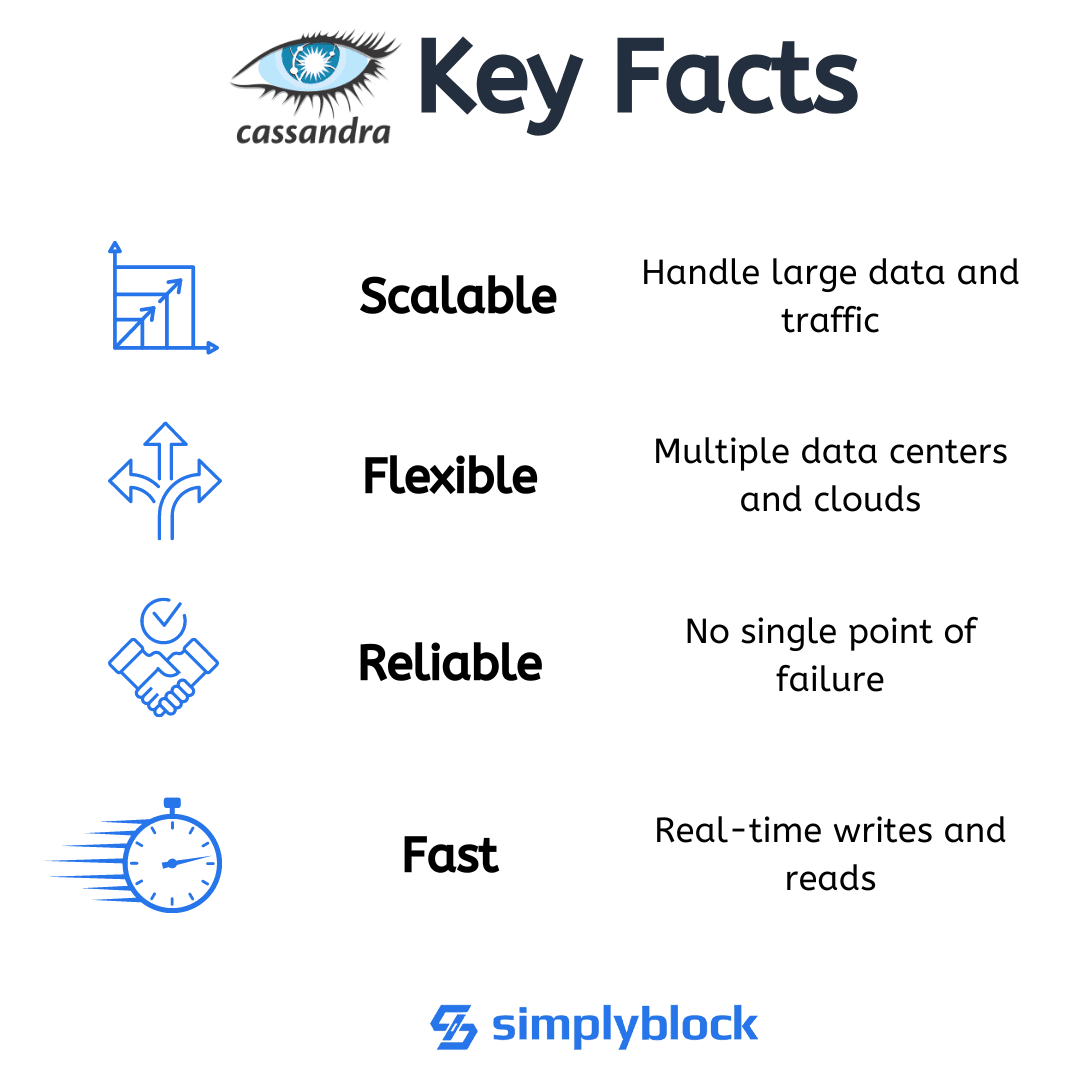Apache Cassandra
Terms related to simplyblock
Apache Cassandra as a Scalable NoSQL Solution for Modern Data Needs
Apache Cassandra is a highly scalable, open-source, distributed NoSQL database designed for handling large volumes of structured data across multiple commodity servers without a single point of failure. It is optimized for high write throughput, fault tolerance, and decentralized architecture, making it a preferred choice for real-time applications requiring high availability, such as analytics, IoT platforms, and time-series databases.
How Does Apache Cassandra Work?
Cassandra operates on a peer-to-peer architecture, where all nodes in the cluster are equal and communicate with each other without a master node. Data is distributed using consistent hashing, and each piece of data is replicated across multiple nodes to ensure fault tolerance. The database uses a log-structured storage engine and supports tunable consistency, allowing configurations between eventual and strong consistency, depending on use case requirements.
Cassandra writes are first logged in a commit log, then written to an in-memory table (memtable), and later flushed to disk in immutable SSTables. This write-optimized approach enables Cassandra to deliver high write throughput even under heavy loads. The built-in gossip protocol ensures cluster state awareness, while the anti-entropy process (via Merkle trees) helps maintain data consistency.
Key Features of Apache Cassandra
- Masterless architecture enabling horizontal scaling without bottlenecks.
- Multi-data center and cloud support for global deployments.
- High availability through data replication and automatic failover.
- Support for SQL-like CQL (Cassandra Query Language) for easy adoption.
- Linearly scalable throughput for reads and writes.
- Integrated with Kubernetes for containerized deployments.

Apache Cassandra vs Traditional RDBMS
While relational databases are ideal for transactional workloads and data integrity, Cassandra excels in handling high-velocity, high-volume data across distributed systems. Its lack of joins, foreign keys, and ACID compliance is compensated by its performance and availability in large-scale environments.
Here’s a simple comparison:
| Feature | Apache Cassandra | Traditional RDBMS (e.g., PostgreSQL) |
|---|---|---|
| Architecture | Distributed, peer-to-peer | Centralized or master-slave |
| Scaling | Horizontal, no downtime | Vertical or manual sharding |
| Write Throughput | High, optimized for fast ingestion | Moderate, optimized for transactions |
| Data Consistency | Tunable (eventual to strong) | Strong (ACID) |
| Fault Tolerance | Built-in, no single point of failure | Limited, usually with external tooling |
Use Cases for Apache Cassandra
Cassandra is best suited for applications requiring:
- Real-time analytics over large, fast-changing datasets.
- Time-series data storage (e.g., IoT, metrics, logs).
- Large-scale data lakes across multiple regions.
- Customer personalization engines.
- Product catalog management in e-commerce.
Kubernetes-native applications benefit from Cassandra’s replication and scaling model. With platforms like simplyblock for Kubernetes, Cassandra’s storage can leverage high-performance NVMe over TCP infrastructure, reducing IOPS bottlenecks common in cloud-native databases.
Storage Considerations for Cassandra
For optimal performance, Cassandra thrives on fast, low-latency block storage. NVMe over TCP offers a compelling backend solution due to its high throughput and compatibility with existing Ethernet infrastructure. Platforms like simplyblock’s NVMe-TCP block storage align with Cassandra’s requirements by providing scalable, distributed, and cost-efficient storage layers.
Features like erasure coding can help reduce redundancy costs while preserving data protection. When paired with Cassandra’s tunable replication, this makes the architecture highly efficient for storage-heavy environments.
Benefits of Running Cassandra with Simplyblock™
Cassandra’s distributed model aligns with simplyblock’s disaggregated and unified storage architecture, which ensures:
- Sub-millisecond latencies via NVMe over TCP.
- Intelligent data placement and multi-tenancy controls.
- Snapshots and clones for faster CI/CD and backup operations.
- Built-in support for hybrid and multi-cloud environments.
- QoS features to balance workloads across tenants and services.
By deploying Cassandra on simplyblock, enterprises gain predictable performance, reduced infrastructure complexity, and improved fault tolerance without SAN lock-in or hardware dependencies.
Related Technologies and Alternatives
Some distributed database alternatives to Apache Cassandra include:
- ScyllaDB: A C++ rewrite of Cassandra for lower latencies
- CockroachDB: Strong consistency and SQL support
- MongoDB: Document store with replica sets and sharding
- TiDB: MySQL-compatible distributed SQL engine
For deeper insights into Cassandra’s performance with different storage backends, you can read the I/O performance breakdown or the NVMe vs. iSCSI comparison.
Questions and Answers
Apache Cassandra is a highly scalable NoSQL database designed for handling large volumes of data across many servers. It’s ideal for real-time analytics, time-series data, and applications needing high availability and fault tolerance.
Cassandra often relies on high IOPS and low-latency storage due to compaction and replication workloads. Using NVMe over TCP instead of iSCSI can significantly reduce storage latency and increase throughput, leading to faster query responses and more stable write paths.
While iSCSI has been widely used, its protocol overhead and limited throughput make it less ideal for Cassandra’s performance needs. Migrating to NVMe/TCP enables better utilization of modern SSDs and reduces bottlenecks for large-scale deployments.
Cassandra benefits from fast, consistent storage with high IOPS. Solutions using NVMe storage or software-defined storage like Simplyblock offer enhanced performance and scalability, making them ideal for modern database workloads.
Yes, Simplyblock supports Kubernetes storage integration and provides logical volumes that are NVMe over TCP capable. This makes it well-suited for stateful workloads like Cassandra, ensuring persistent, fast, and reliable storage.
